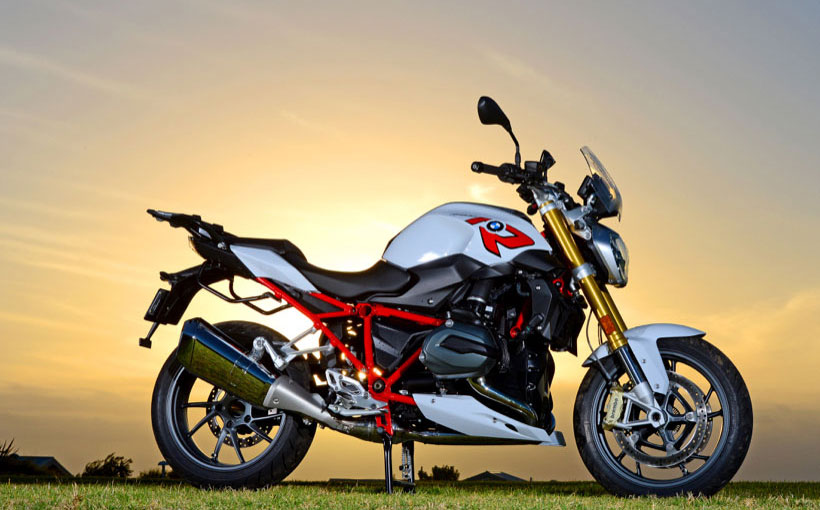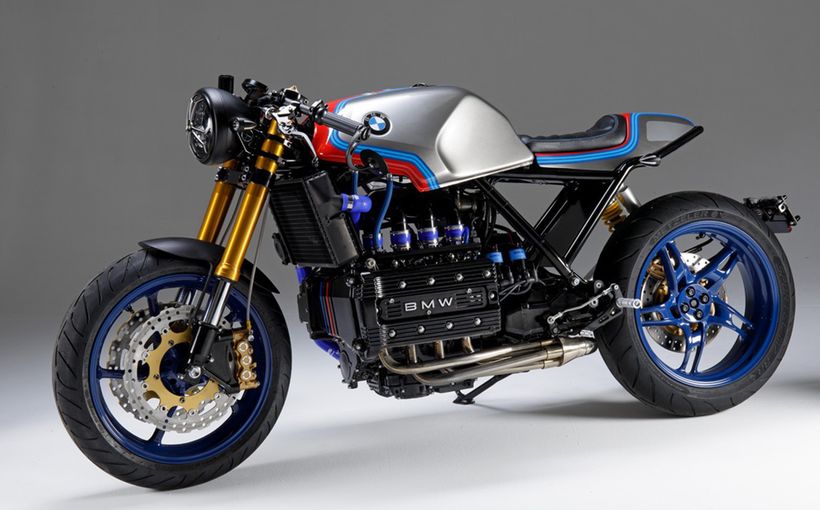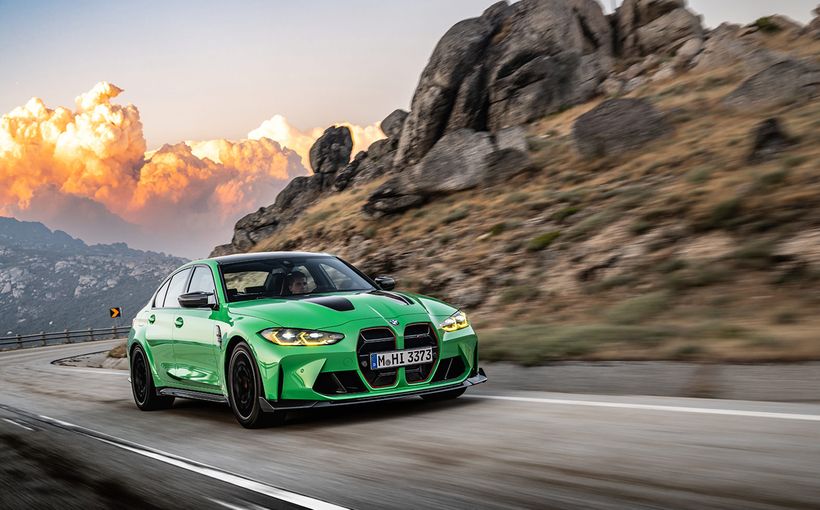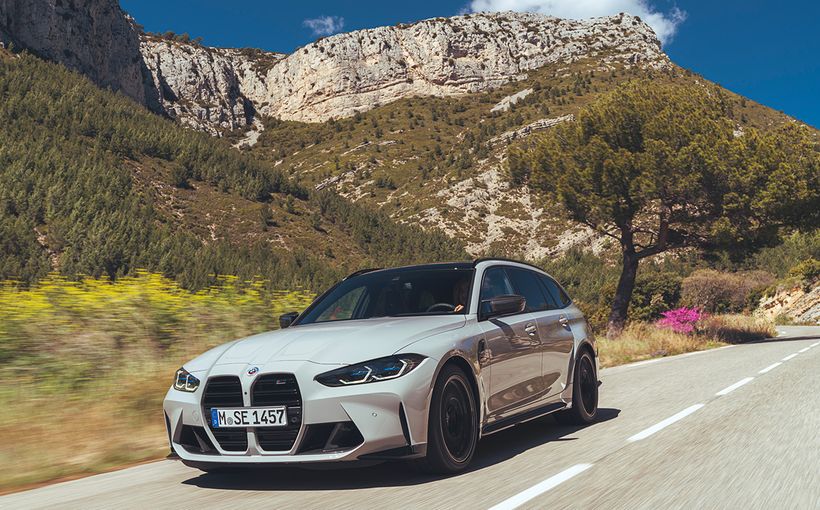
The last boxer to get the water-cooled engine conversion was always going to be the more difficult one. The R1200R had no bodywork — not even a beak like the GS, let alone a massive fairing like the RT under which you could hide radiators and pipes. I’d wondered how BMW might do it. I’d also wondered why it took so long because the cruisy old roadster was definitely feeling its age. Water had proven to be the elixir of youth to the GS and RT, and the two of them made the air-cooled R look weary as they ran rings around it.
Of course it’s more than just the addition of water-cooling that does the trick for the 1200cc boxer engine. The entire powerplant is new, laid out in a way no boxer has ever been before - the gearbox is squeezed tightly into the crankcases, the clutch is a wet, multiplate unit mounted at the front of the engine, and the pairs of camshafts sit on top of the valves, though that’s not quite a first for a BMW boxer. The thing that hits you in the eye is the vertical intake and exhaust run.
The inlet tracts plunge down into the top of the cylinder heads and the exhaust falls out from the bottom, and together they enhance the very upright appearance of the so-called wasserboxer. How were BMW’s designers going to cope with such a radical revision to the centrepiece of the roadster’s styling?
Now we know and if you ask me they’ve done a pretty good job of it. In many ways this is a more conventional-looking motorcycle than the old R1200R, and there’s one unexpected but significant change to the chassis that increases the impression of convention — the telescopic forks. Until the sexy R nineT came along last year, we hadn’t seen telescopic forks on a boxer for more than 20 years. BMW calls it a classic suspension concept.

I asked about this departure from BMW lore and was told that the new model’s sophisticated electronic package made up for any possible deficiencies of telescopic forks compared with the Telelever setup used previously. However, I suspect there’s another, more practical reason for the change: with fewer ways to integrate a radiator on the unfaired R1200, BMW had to make room for the cooler by ditching the Telelever’s swingarm, which would have been mounted right where the radiator is now. No swingarm, no Telelever.
I don’t miss it. It’s not that I don’t like the Telelever — on the contrary, I love it, and it makes my R1200RT a great handling tourer. But the roadster is a little rocket even without it. The new R1200R’s handling and performance are in a higher league than the old bike would ever aspire to.
Let’s get back to the engine for a moment. It makes you go wow when you first get going. It did it to me when I first jumped on the wasserboxer GS; it did it when I first got going on a wasserboxer RT; and again when I engaged the clutch on the wasserboxer roadster while memories of the old model’s rather dull performance ran around my head.
This engine’s power and response are excellent in the context of big, twin-cylinder roadsters. No, it’ll never be an S1000R, but that’s not what we want from it. What you get is surging torque that is just about to punch through 100Nm as the tacho’s needle passes 2000rpm, and it stays strong through to its peak of 125Nm at 6500rpm. Power comes on smoothly, with no pauses until beyond 8000rpm as the rev limiter hovers nearby. All up, the R1200R develops 92kW at 7750rpm. Sound familiar? It’s all identical to the R1200GS and R1200RT, and they now share the heavier crankshaft that was first used in the GS Adventure and proved such a benefit to the engine’s nature that everyone wanted it.

The engine provides strength to the chassis, which features a main frame of thick tubular steel. It feels rigid and maintains constant balance in the way the bike handles. The inclusion of Dynamic ESA semi-active suspension on all Australian-delivered 1200Rs completes the control delivered by the chassis and, yes, does seem to make up for anything the bike might have lost by having no Telelever. The electronic reactions of the suspension to road conditions and demands are a very real benefit for an all-rounder like the R1200R because it broadens the ability of the bike to cover ground quickly and comfortably, pushing it hard or not.
Those up-spec electronics also bring additional riding modes to the equation. The Rain and Road modes, which set the various chassis and engine parameters to suitable levels, are supplemented by Dynamic and User modes. The Dynamic mode gives you sharp throttle response and the ability to powerslide a bit before the traction control intervenes; the electronic suspension is firmer too. The User mode gives you scope to program your own preferences.
It’s a smorgasbord of electronically activated choice and don’t forget you’ve also got suspension adjustment at the touch of a button, providing instant variation to allow for luggage and pillion.
This collection of features comes together as a rewarding and thoroughly enjoyable whole. The R1200R is heaps of fun.

Point it into a corner and the BMW flicks in willingly on a quicker line than the old Telelevered model would have taken. This one responds immediately to your commands through handlebars or with body English, and going side to side in S-bends is pure joy. The bike’s cornering clearance is generous but the machine is sporty enough that an eager rider will scrape the footpegs when they get their lines right. In Dynamic mode the BMW hits hard when you gas it out of corners, and the engine’s flexibility lets you play at medium or high revs and still go fast.
On smoother roads I revelled in the firmer suspension setting, but on choppier surfaces I found I preferred to ride in the Dynamic ESA’s medium setting because it dealt with the imperfections better — better for control and for comfort. The entire setup is firm enough to cope with sporty riding in that mode, though if you step further down to Comfort mode’s softer damping, you’ll lose the edge that keeps it all in line when pushing hard.
I often looked for Comfort mode when just touring along. Changing from one to the other is so easy you don’t baulk at doing it regularly: press the handlebar-mounted button, check the colour dashboard display, and let the new setting establish itself. Changing riding modes is similar but you must also briefly shut the throttle to make the change stick. Once you know the system, you barely have to take your eyes off the road, and even then it’s only for a moment. So from trickling through a small town in top gear with the engine just ticking over, to skimming apexes on a tight mountain road, the R1200R doesn’t go wrong. It has the performance and credentials to nail it all. The more advanced traction control, like the ABS, provides a backup service you’ll sometimes be grateful for, and because of its smarter parameters it doesn’t irritate you nearly as much by cutting in when not necessary.

The riding position is nicely laid out for a naked bike, keeping you reasonably upright so that boring drones at 100km/h don’t put much pressure on your wrists but, equally, when you’re heading into a stiffer wind you don’t find yourself hanging on grimly and getting tired. The little windshield provides its share of wind deflection in spite of its diminutive size. There’s plenty of room, a 790mm-high seat (higher 820mm or lower 760mm perches are available as no-cost options) and no restrictions to moving around when cornering. The seat is firm and wide enough at the back for support, but narrow at the front for convenience. I also tried the taller seat and I liked its height (I’m 183cm) as well as the little bit of extra padding it has. Your pillion is treated to generous leg room and a slightly elevated seat, though its not the biggest patch to park a bum on.
As always, though, the boxer’s vibration can be annoying. The R1200R seems to transmit a bit more of it to the handlebars than the GS and RT. In the boom half of the rev range it’s a pleasant low-frequency pulse but the faster you rev the engine, the more tingly it becomes. I reckon it’s the one blemish on an otherwise impeccable roadster.
There are lots of great roadsters out there today. Singles, twins, triples and fours, there’s an overwhelming selection of models ranging from cheap to heaps. The R1200R sits with the high-class ones, offering very sophisticated features that increase its desirability and effectiveness. It’s not the most powerful but it’s got the grunt to turn you on, and its handling is very good.
The bike covers one of the broadest briefs of all the roadsters — it’ll cheerfully be the commuter, the tourer, and the sporty plaything in a way that’s closer to master of all trades than jack of all.
Think of it as an expert all-rounder. That’s where its true values lies, and in that case it looks like pretty good value all-round.
OPTIONED UP
The test bikes I rode all had options, most of which I’d happily add to an R1200R if I were to buy one.
The new boxer engine’s wet, multiplate clutch and revised transmission result in a gear-shift action that’s far superior to the old engine’s, but it’s better again with the quick-shift option. BMW’s Gear Shift Assistant Pro is a $600 impost, but I’ve come to love it on the R1200RT long-termer and it was no less enjoyable on the roadster.
Same goes for the Keyless Ride. It quickly grows on you. Fiddling with a key is overrated and you don’t miss it one bit.This is $345 easily spent.
The main attraction of the Touring package ($600) is the pannier mounts, but of course you then have to fork out for the panniers.The package also comes with the excellent and detailed information of the On Board Computer Pro — a very fancy trip computer — a luggage rack, centre stand and all the hardware to mount BMW’s GPS unit. If you’ll do much distance on your R1200R, all this is worth having.
RED ONES GO FASTER
The white R1200R with red frame is a standout, especially beside the very conservative colours of the other roadsters. There’s a great story behind it.
“We made up a prototype with one side of the frame painted black and the other painted red,” project leader Josef “Sep” Mächler told ARR, adding that he and the stylists knew it’d be hard to get approval for the red frame. There were major technical issues to overcome because BMW did not have a red finish that was tough enough for a frame.
“When we took it to the board for approval, we showed them the black side first.Then we spun it around and showed them the red frame.They loved it and demanded we make it. R&D hated it!They had to develop a red finish that was hard enough.”
Sep and his team weren’t very popular with the engineers, but it appears the subterfuge and the subsequent development efforts were worth it.











